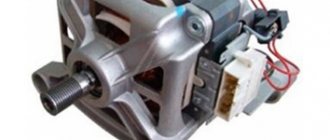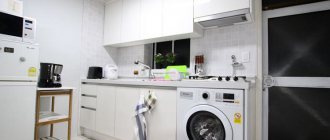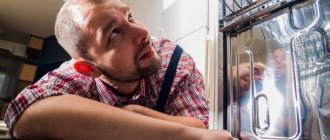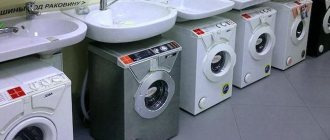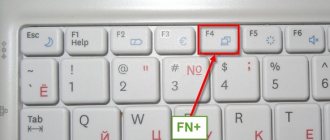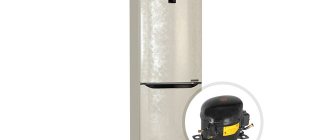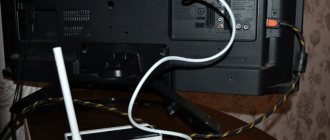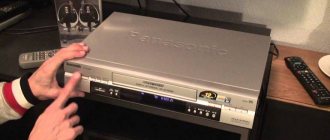How to connect a motor from a washing machine with three terminals
Washing machines, over time, fail or become obsolete. As a rule, the basis of any washing machine is its electric motor, which can be used even after disassembling the washing machine for spare parts.
The power of such engines, as a rule, is not less than 200 W, and sometimes much more; the shaft speed can reach up to 11,000 rpm, which may well be suitable for using such an engine for household or small industrial needs.
Here are just a few ideas for the successful use of an electric motor from a washing machine:
There can be many options for using an electric motor; the essence of the process lies in the ability to rotate various mechanisms and devices at high speeds. But no matter what mechanism you are going to design, you still need to correctly connect the motor from the washing machine.
Types of engines
Washing machines of different generations and countries of production may have different types of electric motors. Typically this is one of three options:
Asynchronous
.
Basically, these are all three-phase motors, they can also be two-phase, but this is very rare. Such engines are simple in their design and maintenance; basically it all comes down to lubrication of the bearings. The disadvantage is the large weight and dimensions with low efficiency. Such motors are found in older, low-power and inexpensive models of washing machines. Collector.
Motors that replaced large and heavy asynchronous devices. Such a motor can operate on either AC or DC power; in practice, it will even rotate from a 12-volt car battery. The motor can rotate in the direction we need; to do this, we just need to change the polarity of connecting the brushes to the stator windings. High rotation speed, smooth change in speed by changing the applied voltage, small size and large starting torque are just a small part of the advantages of this type of motor. Disadvantages include wear of the collector drum and brushes and increased heating during short-term operation. More frequent maintenance is also necessary, such as commutator cleaning and brush replacement.
Inverter (brushless)
An innovative type of motor with direct drive and small dimensions with fairly low power and high efficiency. The engine design still contains a stator and a rotor, but the number of connecting elements is reduced to a minimum. The absence of elements subject to rapid wear, as well as low noise levels. Such motors are found in the latest models of washing machines and their production requires relatively more costs and effort, which of course affects the price.
Connection diagrams
Motor type with starting winding (old/cheap washing machines)
First you need a tester or multimeter. You need to find two pairs of pins corresponding to each other. Using the tester's probes, in continuity or resistance mode, you need to find two wires that are connected to each other, the remaining two wires will automatically be a pair of the second winding.
Next we need to figure out where we have the starting winding and where the working winding is. You need to measure their resistance: a higher resistance will indicate the starting winding (PO)
, which creates the initial torque. A lower resistance will indicate to us the field winding (OB) or, in other words, the working winding that creates a magnetic field of rotation.
Instead of the “SB” contactor, there can be a low-capacity non-polar capacitor (about 2-4 µF) This is how it is arranged in the washing machine itself for convenience.
If the engine starts without a load, that is, does not wake up a pulley with a load on its shaft at the moment of starting, then such an engine can start itself, without a capacitor and short-term “powering” of the starting winding.
If the engine overheats greatly
or it heats up even without load for a short time, then there may be several reasons. Perhaps the bearings are worn out or the gap between the stator and rotor has decreased, causing them to touch each other. But most often the cause may be a high capacitance of the capacitor; it’s easy to check - let the engine run with the starting capacitor disconnected and everything will immediately become clear. If necessary, it is better to reduce the capacitance of the capacitor to the minimum at which it copes with starting the electric motor.
In the button, the “SB” contact must strictly not be fixed; you can simply use the doorbell button, otherwise the starting winding may burn out.
At the moment of startup, the “SB” button is pressed until the shaft spins up completely (1-2 seconds), then the button is released and voltage is not supplied to the starting winding. If reverse is necessary, you need to change the winding contacts.
Sometimes such a motor may have not four, but three wires at the output, in which case two windings are already connected at the midpoint to each other, as shown in the diagram. In any case, when disassembling the old washing machine, you can take a closer look at how its motor was connected to it.
When there is a need to implement reverse
or change the direction of rotation of the motor with the starting winding, you can connect according to the following diagram:
Collector type motor (modern, automatic washing machines with vertical loading)
As a rule, these are commutator motors without a starting winding, which do not require a starting capacitor; such motors operate on both direct current and alternating current.
Such a motor may have about 5 - 8 terminals on the terminal device, but to operate the motor outside the washing machine, we do not need them. First of all, you need to eliminate unnecessary tachometer contacts. The resistance of the tachometer windings is approximately 60 - 70 Ohms.
Thermal protection terminals can also be output, which are rare, but we also don’t need them; this is usually a normally closed or open contact with “zero” resistance.
Next we connect the voltage to one of the winding terminals. Its second output is connected to the first brush. The second brush is connected to the remaining 220-volt wire. The engine should start and rotate in one direction.
To change the direction of movement of the motor, the connections of the brushes should be swapped: now the first will be connected to the network, and the second will be connected to the output of the winding.
Such an engine can be tested with a 12-volt car battery, without fear of “burning” it because it was connected incorrectly; you can easily “experiment” with reverse and see how the engine operates at low speeds from low voltage.
When connecting to a voltage of 220 volts, keep in mind that the engine will start abruptly with a jerk, so it is better to secure it motionless so that it does not damage or short-circuit the wires.
You can find out in some detail about how to connect three-phase asynchronous motors to a regular 220-volt household network in the article - “Connecting a three-phase motor”
Speed controller
If there is a need to regulate the number of revolutions, you can use a household lighting controller (dimmer). But for this purpose, you need to select a dimmer whose power will be more powerful than the engine power, or modification will be required; you can remove a triac with a radiator from the same washing machine and solder it in place of the low-power part in the design of the dimmer. But here you already need to have skills in working with electronics.
Types of engines
Important! There are only three types of motors installed on washing machines: asynchronous, commutator and direct (inverter).
Asynchronous
An asynchronous motor was installed in cars produced in the USSR (Riga-60, Vyatka-automatic). It consists of two parts: stator and rotor. The motor got its name due to its inability to rotate synchronously with the magnetic field (it constantly lags behind). There are two options for an asynchronous motor: two- and three-phase. Older models (for example, Riga) had two-phase motors installed. But with the advent of the new millennium, such engines almost ceased to be produced.
Asynchronous motor of the washing machine Vyatka
The main advantages of an asynchronous motor:
- simple design;
- maintenance is limited to changing oil and bearings;
- minimum noise level during operation;
- cheapness.
The disadvantages of the electric motors of the Donbass washing machine and other older models are their dimensions, high electricity consumption and difficulty in setting them up.
To remove an asynchronous motor (for example, from a Malyutka washing machine), you will have to disassemble the entire housing. Then loosen the motor mounts, remove the belt and disconnect the retaining ring. After this, all that remains is to remove the pulley from the shaft and disconnect the electrical wires from the clamps.
Electric motor of the Malyutka washing machine
Collector
The commutator electric motor gradually began to displace the asynchronous motor from the household appliances market . The main advantage of its design is the ability to operate on both alternating and direct current . The rotation speed of the rotor directly depends on the applied voltage. In addition, such motors are capable of rotating in both directions. Commutator motors are found in most household appliances. So, they can be found in washing machines of the following models: INDESCO, CESET, WELLING, SELNI, FHP, SOLE, ACC.
The strengths of this device are:
- a large number of revolutions;
- smooth speed increase;
- compactness.
Weaknesses include a short lifespan.
Important! Often such motors break down due to an interturn short circuit, that is, the contacts on the rotor and commutator touch. Therefore, the magnetic field is weakened and the drum stops rotating.
Inverter
The direct (inverter or brushless) type of electric motors is found only in modern models of washing machines (for example, Indesit). This technology hit the market just ten years ago. Unlike the previously mentioned designs, the motor is connected to the drum directly, without the use of intermediate parts.
The advantages of an inverter motor include:
- long service life;
- wear resistance;
- compactness.
The main disadvantage is the high cost of production, which seriously affects the price for the user of the final product.
To remove the electric motor from a modern washing machine, you need to remove the back (typical of Indesit, Zanussi, Ariston) or front (typical of Samsung, Bosch, LG) panel. If you only need to unscrew the bolts on the back wall, then from the front you will have to remove the control panel, base and top cover. The engine will be located at the bottom of the machine. To dismantle it, you need to remove the drive belt and disconnect the grounding and power wires. Next, you need to unscrew the motor mounts and remove the device by picking it up with a thin object. If all the screws are unscrewed, then you can use a little force, since the fasteners often stick.
How to connect a motor from an old washing machine
An automatic washing machine, like any other equipment, sooner or later fails. It happens that repairs do not justify themselves, and then it is easier to buy a new unit. What to do with your old house help? You can simply send it to a landfill, or you can try to get the most out of all its working parts.
The engine is one of the parts of the washing machine that can get a “second life”. In our article we will tell you how to connect the motor from a washing machine to another device.
Washing machine motor connector
The washing machine motor connector resembles the notorious plastic connector, painfully familiar to computer scientists. It fits together easily, but cannot be pulled back apart. Repairmen help their hands with a slotted screwdriver. Each half contains more than 10 contacts, some of them are not used. Here's what pins could be used for (read, it will be useful when studying):
- Two per rotor, stator, in total, four terminals form the ends of the windings. The middle is sometimes removed from the fixed part. Helps implement various operating modes of equipment. Speed control usually occurs by changing the voltage cutoff angle. Imagine: a smooth sine wave with an effective value of 230 volts comes from the outlet. Lots of engine. Part of the sinusoid period is cut off by a power switch. For example, a thyristor. The effective voltage value drops rapidly. Samsungs have a Korean engine with hieroglyphs, in Russian (though in English) it is written (take it with a pencil if you need to determine the power of the electric motor) that in spin mode it consumes 300 W (input current 3 A), washing - 40 W (current 4 A). How to understand - more current, less consumption? No. It's just that the cutoff angle is different. In the first case, the effective value will be 300/3 = 100 V, in the second - 40/4 = 10 V. Speed control will be needed by homemade ones. Or supply voltage through a transformer.
Engine parameters measurement
- As for the rotation speed, the tachogenerator (more like a tachometer) helps to estimate the figure. It essentially becomes a source of pulses that travel synchronously with the shaft; it has at least two connector pins. One small complication: the tachogenerator has moving parts. Minus equipment reliability. The Hall sensor is most often used. A plate of conductive material that responds to an approaching magnetic field. The pulse repetition rate changes according to the speed of the shaft. The plate can last forever. There is no mechanical contact, there are no moving parts. The Hall sensor is used not only to control the speed of the shaft in order to implement a washing program. Helps weigh laundry. After soaking, the fabric becomes wet; the weight determines the speed at which the drum spins. Using special formulas, the equipment calculates the weight of the laundry. Please note that the Hall sensor has three terminals. Two are powered, impulses are taken from the third.
- Most electric motors contain protection against overheating. It is implemented using a primitive thermal fuse. Overheating occurs - the element burns out. The connector has two pins. Used by circuit continuity monitoring circuitry. The central processor can monitor; in the simplest case, the motor windings are simply powered through protection. The thermal fuse is often mounted on the motor housing. For washing machines, the motor is made so that something resembling a magnetic circuit (a set of steel plates) is formed along the contour. The thermal fuse is located either there or under the insulation of the windings. It doesn't matter to our goals if there is no fear of burning out the engine. It is better to turn on the equipment through a protective circuit. The thermal fuse is in series with the windings.
The circuit is simple, now we are trying to understand the connector layout. It's easier to find the brush contacts. You'll have to ring from the side of the graphite rods. Moreover, the brushes must be removed. Then comes the turn of the stator winding. There should be a resistance of 10 - 30 ohms. Where the thermal fuse is located, this cannot happen: either a short circuit or a break. As for the tachometer, the situation will be similar. The operating principle of the part is usually extremely simple.
Let's find a method to clearly understand where the stator is located? Find a complete copy of the household appliance; you can tell a lot by the thickness of the wires. The motor from the washing machine is connected using a thick wire. The sensors are connected thin. The second sign is the relationship to the relay that controls the direction of movement of the shaft. Trace the wiring route. Try to guess by the color of the cambric (braid). If the corresponding tone enters the stator, it is a winding. Please note that the colors of the wires in the mating and straight parts of the connector do not match. Why? We believe the question will remain unanswered.
We recommend finding the thermal fuse, if available. The oblong body is hidden in a cambric, and the side contacts stick out. There are other designs; using a tester it is easy to find the corresponding connector pins. Some of the problems will be solved. Remember that six contacts are required:
- Two stator windings and brushes.
- Two pieces for the tachometer (three pieces for the Hall sensor).
The thermal fuse is considered an option and is installed in most washing machines. Be as precise as possible with the layout, because supplying 230 volts to the RPM sensor will not be the best idea.
How to use the engine
The electric motors that modern units, such as those from Indesit, are equipped with are quite reliable and durable. And even a part from an old washing machine of a brand like Vyatka can last long after the equipment itself has become hopelessly outdated.
In a washing machine, an electric motor rotates the shaft, which drives the drum. If the part is removed from the unit, a wide variety of attachments can be attached to the shaft, resulting in new tools and accessories. The most common ways to use an electric motor are:
We have listed only a small part of the devices that can be obtained from a washing machine motor. In order to make one of them, or come up with your own application, you need to know how to connect the motor so that the winding does not burn out.
Connection procedure
It is important to keep in mind that the washing machine engine does not start through a capacitor; a starting winding is not needed to start it.
Before we start connecting, let's look at what wires are in the transfer case of the washing machine engine:
The wires leading to the tachogenerator can be put aside - we don’t need them. In different models of washing machines, the color of the wires may differ, so you can get your bearings by the resistance - in those that go to the sensor, it should be 60-70 Ohms. After the extra wires have been isolated, the remaining ones need to be “ringed” to find a pair for everyone.
Before performing work, you should firmly fix the motor on any surface - the shaft will begin to rotate immediately after connecting to 220 V.
Typically, motors come with 4 leads (that is, they have 4 wires coming from the motor). If your motor has 5 pins, 6 pins, or even 7 pins, make sure there are no extra ones - we only need wires from the rotor and stator.
Next you need to connect the motor according to the diagram shown in the figure below.
According to the diagram, you need to connect the stator winding to the rotor brush, so you need to find the corresponding wires and make a jumper between them (in the photo it is indicated in pink), and then insulate it. The remaining two wires - from the rotor winding and the second brush - are connected to the network.
All that remains is to supplement the device with on and off buttons. In order to change the direction of rotation of the shaft, it is enough to transfer the jumper to other contacts.
On old Soviet units, motors with 3 leads can be installed. How to connect such a “miracle of technology”?
First of all, you need to measure the resistance: between pins 1 and 2, as well as pins 2 and 3, the ohmmeter will show 10 Ohms, and between pins 1 and 3 – 20 Ohms. The motor is connected as follows: pins 1 and 2 - to the network, pin 3 - through a capacitor to pin 1.
So, connecting the motor from the washing machine is not difficult. Use our recommendations, do not forget about safety precautions, and give a “second life” to your equipment.
We begin diagnostics and repair of engines
Now let's talk in more detail about repairing the most common faults in electric motors of washing machines.
Diagnostics of electric motors
Correct diagnosis is half the work when repairing
Let's figure out how to diagnose electric motors when they break down. To do this, we need an ordinary multimeter - a device that almost every “homemade person with hands” has. The easiest to diagnose is the commutator motor, so if this is what is installed in your washing machine, you can easily do everything yourself.
So, the first thing we need to do is remove the motor from the washing machine. Here are step-by-step instructions on how to do it.
Removing the engine
- We disconnect the washing machine from the electrical network and move it to a free place so that we can freely approach it from any side.
- Remove the inspection hatch using a screwdriver or screwdriver. For side-loading machines, this is the rear panel, and for top-loading machines, it is the side panel. We unscrew all the screws and move the panel down.
- Next, you need to remove the belt - this is done very simply, just pull it towards you where it fits onto the pulley (a large wheel connected to the drum), and turn it a little. If you've ever changed a chain on a bicycle, the principle will be intuitive to you.
- Then remove the power and ground terminals from the motor.
Bosch 1200 washing machine and electric motor repair
- Now you need to unscrew the bolts that hold the engine. It is most convenient to use a spanner wrench for these purposes.
- All that remains is to remove the engine. It is supported by straight heels, so it needs to be lowered a little and pushed forward, and sometimes considerable effort is required. You can try lightly tapping with a hammer, but it is better not to disturb the engine and remove it with smooth rocking movements.
After the motor is removed, you need to test run it. To do this, we connect the rotor and stator windings in series, and connect an alternating current source with a voltage of 220 V to the remaining connectors.
Attention! You also need to include some kind of heating element in the circuit, for example from a washing machine, or a powerful lamp of at least 500 W. This must be done in order to protect yourself in case a short circuit occurs in the engine. If there is a short circuit, the heating element will begin to sharply increase its temperature, and the lamp will burn brightly.
It would be better if it is possible to power the circuit using a car transformer with a power exceeding 500 W. This will allow you to more clearly control the speed of the running engine. For greater safety, you can include 5 or 10 Amp fuses in the circuit.
If the engine is rotating, then carefully look at the intensity of the sparking at the point of contact between the brushes and the commutator; if it is strong, then there is a high probability that the motor is faulty. Most often, the commutator lamellas, rotor and stator windings, and brushes become faulty.
Continuity testing of individual engine parts
Repairing a washing machine when the electric motor gets hot
If your engine was not producing full power and was making strange noises, and after a test run you determined that it was getting very hot, then the problem is most likely a faulty rotor or stator winding. You can check this using a multimeter, which must be switched to resistance measurement mode.
Continuity of the rotor winding
We successively touch the probes of the device to the adjacent rotor lamellas. Differences in measurements should not exceed 0.5 ohms, and their value should correspond to the data specified in the engine passport, if any. If significant differences are detected, then we can safely state a short circuit between the turns.
In some cases, such a malfunction can be determined tactilely and by smell. Due to the fact that lower resistance causes an increase in current strength, and as a result - overheating, individual lamellas may have a higher temperature than others. At the same time, you will feel a characteristic burning smell.
If during testing the resistance tends to infinity, then this indicates a break in one of the windings.
Continuity of the stator winding
Next you need to ring the stator. The procedure is similar to that described above. First, we measure the resistance between the contact connections of the windings, as shown in the photo above.
Then we look at the short circuit of the windings to the housing (stator iron). To do this, we touch the body with one probe, and with the second we pass through all the contact rings in turn.
Checking the resistance between the winding and the housing
A working stator will have very high resistance values - sometimes hundreds of Mega Ohms.
Determining the wear of the lamellas
The commutator constantly rubs against the brushes
The lamellas are fixed to the rotor using a special adhesive. If the rotor is jammed or there is an interturn short circuit, they may begin to peel off as a result of overheating. A contact break in the rotor section may also occur.
Burrs may appear on the lamellas, due to which the brushes begin to quickly collapse and spark strongly. In addition to rotor jamming, the cause of such a breakdown in machines with vertical loading can be the start of washing with the drum flaps open.
Video
In the video below, you can once again familiarize yourself with the procedure for connecting the motor from the washing machine.
Mom, wife and just a happy woman. She draws inspiration from travel and cannot imagine life without books and good films. She strives to become an ideal housewife and is always ready to share her experience.
Found a mistake? Select it and click the buttons:
The first officially patented washing machine was made of wood and was a box with a frame, half filled with wooden balls. Laundry for washing and detergent were loaded inside and the frame was moved using a lever, which, in turn, made the balls move and grind the laundry.
The expression “soap opera” (“soap”) did not arise by chance. The very first series and shows that had a female audience were broadcast on television at a time when housewives did cleaning, ironing and laundry. In addition, to attract female viewers to the screens, commercials for detergents: soaps and powders were often played on air.
There is a washing machine “for bachelors”. Linen washed in such a unit does not need to be ironed at all! The thing is that the device does not have a drum: some things can be placed inside the container directly on hangers (for example, jackets and shirts), and smaller things (for example, underwear and socks) can be placed on special shelves.
History knows the fact that a kitten fell into the drum of a washing machine and, after going through a full wash cycle on the “Wool” program, got out of the unit unharmed. The only trouble for the pet was an allergy to washing powder.
In the 19th century, washing ladies' toilets took a lot of time. The dresses were first ripped open, and then each part was washed and dried separately so that the fabric did not become deformed. After washing, the clothes were sewn again.
Astronauts, while in Earth orbit, solve the problem of dirty things using an original method. Clothes are dropped from the spacecraft and burn up in the upper atmosphere.
Washing machines equipped with the “No Iron” or “Easy Iron” functions can wash clothes with little to no wrinkling. This effect is achieved through a special approach to spinning - it is performed at low speeds, with long pauses, and a small amount of water is retained in the tank.
For washing small items on the road or in a hotel, it is convenient to use a regular plastic bag. Socks or tights are kneaded inside a tied bag along with water and a small amount of detergent. This method allows you to pre-soak things and wash them without damaging the fabric or wasting a lot of powder and water.
There are a variety of balls that are used in the washing machine. Antistatic ones will prevent the fabric from sticking to the body after washing, balls with special loops will “comb” the lint and prevent the appearance of pills, and silicone ones with pimples will prevent fluff from matting when washing outerwear.
Source
Connection diagram for the motor from the washing machine
Good motors are in washing machines, even when the latter breaks down and is thrown away - the motors are left and later used in the household (for example, for a mini-machine). Here we will consider a typical motor from an automatic washing machine (new and old type) and a diagram of its separate connection to 220 V. But first, let me lay out a little boring theory, which you can skip by moving on to the second, practical, part of the article.
Causes of malfunction
- Every user should know how to check motor brushes. By transmitting current, the brushes quickly wear out, which can cause the washer to stop.
- The cause of MMA failure may be worn lamellas. Their connectors become rubbed and nicks form, which requires replacement or repair of the washing machine motor.
- If there is a break in the stator or rotor windings (this may be the result of a short circuit), then repairs also cannot be avoided.
Before resorting to replacing parts, let's find out how to check the commutator motor in a washing machine.
Theory of operation of a 220 V electric motor
Asynchronous motors for single-phase networks are mainly motors with two-phase windings and an auxiliary phase taken from a capacitor. Such motors are used in household appliances. A similar motor is used, in particular, to drive a washing machine. In addition to two-phase winding motors, three-phase winding motors are sometimes used in some other household appliances.
During direct starting, the motor can receive a current from the network that significantly exceeds its rated value. This current is called the motor starting current, and its value varies in the region Ir = 5-7In .
One way to reduce the inrush current is to use a star-delta switch. A motor designed to operate the stator in a triangular connection at a given mains voltage is connected to the star system at the time of start-up:
Capacitor for electric motor
For small engines (
For larger motors (>1kW) a capacitance of around 70uF/1kW is suggested. It is necessary to use starting capacitors with operating voltages of 400..630 V AC.
You can omit the calculations and simply connect a standard motor from the washing machine to 1 phase 220 V through a 7 microfarad capacitor connected between the required terminals. Connect the first power wire to the middle, and the second, depending on the direction of rotation, to one of the capacitor wires. The power drop will be 30% - this is in theory.
The issue of choosing a capacitor is easily resolved. Here are examples of capacitance values for different engine powers.
Pn [W] 90 120 180 250 370 550 750 1100 S [µF] 4 5 6 8 12 16 20 30
The rotation power in the washing machine is the same in both directions. These are motors with a typical connection for a single-phase motor. The main winding is connected directly to 220 V and a phase winding is connected in parallel with it along with a series-connected capacitor. If you reverse the phase winding wires, the motor will rotate in the other direction, but the power will be slightly less. This circuit works during the spin cycle. The same for slow and fast rotations - the capacitance switches inside the washer from 7 µF to 16 µF. Read more about the capacitor here
How to turn on an asynchronous type motor
The asynchronous system consists of:
- The stator is a fixed base.
- Rotor - the element that rotates the drum.
The SM used three-phase motors that can fully operate at a voltage of 380 V. Connecting the motor from the washing machine to a single-phase 220 V network requires connecting a capacitor.
It will reduce the power of the device, but will make the work safer.
Choose a capacitor more powerful than the motor, then it will withstand voltage surges.
Three-phase connection diagram
You will need a set of accessories:
- multimeter;
- capacitor;
- wire - a plug at one end, three terminals at the opposite;
- intermediate wire, terminals at the edges.
Connection:
- Take the power cable and connect the capacitor.
- Attach the intermediate jumper wire to the other side of the capacitor.
- Ring the winding to find the lowest resistance outputs.
- Insert the straight wires that will connect to the outlet.
- Connect the capacitor.
If you cannot hear the motor noise after plugging it into the outlet, most likely the starting capacitor is connected incorrectly. You will have to look for the right terminal using the “scientific poking method”. A detailed description and the result of the experiment with three wires can be seen in this video:
Connecting the motor from the SMA
This motor contains two independent windings:
for synchronous speed 3000 rpm - two-phase winding.
for synchronous speed 500 rpm - symmetrical three-phase winding . The three-phase connection system allows you to change the rotation speed by switching the power supply to the winding.
An older type motor usually has 5 wires, black, blue, white, red and green. A series of measurements were carried out to determine the windings and the resistance between them:
Connecting an old electric motor requires finding the starting winding using a multimeter.
Connecting the electric motor from a new washing machine
If you look at the terminal block with the wires on the front, usually the first two wires on the left are the tach wires, which measure and regulate the rotation speed of the washing machine motor. We don’t need them - they are crossed out with a cross.
In different models of washing machines, the wires differ in color, but the connection principle remains the same. You just need to find the necessary wires by testing them with a multimeter.
A working tachogenerator in a quiet state usually has a resistance of 50-100 Ohms. You will immediately find these wires and disconnect them.
If you need to change the engine speed in the opposite direction, simply drag the jumper to the other pins. Look at the diagrams to see what it looks like.
Two contacts go through the brushes to the rotor windings, and the other two contacts go to the stator winding. The remaining contacts are a sensor for measuring the motor rotation speed. The rotor and stator windings are connected in series and by changing the ends of one of the windings, you change the direction of rotation. Without an electronic regulator, the engine will accelerate to several thousand revolutions per minute (as at maximum spin).
How to connect the motor from a washing machine?
Having served their allotted time, automatic washing machines break down and must be replaced, but there is no need to rush to throw the old equipment into the trash. Many washing machines still have an electric motor in good condition, which, if desired and at least minimal skills in working with electrical engineering, can be used not only for various household needs, but also for carrying out small production work. The electric motor from the washing machine can be connected to a power supply with a voltage of 220 W, and its speed reaches very impressive figures - 10-11,000 revolutions per minute.
An electric motor can be connected to any equipment, for example, to make a device for sharpening knives, a mixer for mixing concrete mortar, to build a small home lathe or sharpening machine, a grinding device, to make a powerful fan or heat gun for heating a garage or cottage, to create a grinder for materials various factions and so on. Craftsmen even make an electric generator from an old engine. The main thing is your desire and skill.
The designs and applications can be anything, but a used electric motor from a washing machine will help set them in motion, which will greatly facilitate your manual labor and become a good economic aid.
Description of different types of electric motors
A modern automatic washing machine, as a rule, has a three-phase electric motor, but old Soviet analogues could also have a two-speed operating mode, although they are now very rare. Any electric motor is a device that operates using electricity, and it is intended to drive various structural elements.
When disassembling a washing machine, you can see in it an electric motor with a tachogenerator, which regulates the number of revolutions made by the rotating shaft, and depending on the type, the electric motor can be brushed or designed without the use of brushes. Different manufacturers of automatic washing machines use certain types of electric motors for different models, which are divided into 3 options.
Asynchronous
Most often, asynchronous electric motors are three-phase, but among them, older models of washing machines sometimes come across two-phase options. Asynchronous electric motors are used in 90% of household appliances, since their design is reliable and inexpensive. The basic principle of operation of such an electric motor is the combined action of the stator magnetic field and the fluxes that are generated by this field in the rotor. The rotation of the electric motor occurs due to the difference in frequencies that arise during the rotation of magnetic fields.
Asynchronous electric motors are reliable and durable; their maintenance consists of regular lubrication of the internal bearing mechanism. However, such an electric motor has a lot of weight and bulky dimensions, which is not always convenient during its use.
The efficiency of asynchronous electric motors is not the highest, so they are used for household models of medium-power washing machines.
Collector
This type of electric motor has become a modern modification, which has replaced large asynchronous models with low efficiency. In contrast, a commutator electric motor has the ability to operate on both direct and alternating voltage. An electric motor consists of a stationary stator and a movable rotor. The stator generates energy, and the rotor transmits it to the rotating shaft, which is its component. The shaft has a collector, thanks to which electricity is supplied to the rotor winding.
Such an electric motor is capable of rotating in any desired direction, that is, to the right or left, you just need to change its polarity when connecting the brushes on the stator winding. The commutator type of electric motor is characterized not only by its high speed of rotation, but also by the ability to smoothly change the speed mode, which is regulated by changing the voltage. The commutator electric motor has compact dimensions, in addition, it is characterized by a large starting torque.
Existing types of electric motors
Modern washing machines are equipped, as a rule, with single-phase electric motors with tachogenerators that regulate the speed. Soviet-era electric motors are already considered a rarity; they are distinguished by a two-speed operating mode. Motors installed in modern washing machines can be divided into three types - these are motors:
- asynchronous;
- collector;
- inverter
Asynchronous
For motors of this type, the rotor speed differs from the speed of the magnetic field of the stator winding. This is the most common type of electric motor. Washing machines are equipped with asynchronous capacitor motors, powered from a single-phase household electrical network.
The stator has two windings, one of which is connected directly to the network, and the second winding is connected to a starting capacitor, forming a starting rotating magnetic field.
The advantage of asynchronous engines is their simplicity of design and ease of maintenance. Wear-resistant electric motors can last for decades if properly maintained.
The disadvantages of asynchronous motors include sensitivity to fluctuations in the frequency of the mains current and the inability to change the shaft rotation speed during operation, but this does not prevent them from being used in various home-made devices.
Collector
Many washing machines today are equipped with commutator motors. A distinctive feature is the presence of 2 brushes. The brushes are adjacent to the rotor commutator, imparting electricity to it, which causes the rotor to rotate in the magnetic field of the stator winding. Collector power units operate using a belt transmission of torque.
The advantages include the presence of a pulley on the motor shaft, which makes it easier for home craftsmen to create devices with a belt drive, and the ability to operate on direct current. As a rule, motors are small in size and controlled by a simple electrical circuit.
The disadvantage is the rapid wear of the belt and the “ability” of the brushes to fail at the most unexpected moment. Still, these can be considered minor trifles compared to the benefits.
Inverter
For the first time, an inverter motor was installed in a washing machine by LG in 2005. Since then, inverter-type motors have been widely used by leading companies in household washing machines. Unlike its analogues, the inverter is attached directly to the drum of the machine and does not require a belt drive or bearings.
The advantages of a direct drive inverter are simplicity of design, compactness, the ability to assign different operating modes, low noise and high efficiency due to the absence of loads from belt drive friction.
The downside is the impracticality of repairs in the event of an electric motor failure. The cost of restoration may be greater than the value of the engine itself. Also considered a disadvantage is the impossibility of use in various home-made machines and mechanical devices due to the design features of inverters.
Connection diagram
Connection to the power supply network for new generation washing machines is made using a special block with terminals. If you have a commutator engine, then this block will contain:
Inside the engine, the connections are located in the transfer block.
Before connecting an electric motor from an old washing machine, it is necessary not only to determine its type, but also to find all the existing electrical wires in the dispensing unit. You should find 2 white wires there that come from the tachogenerator, then find the red and brown wires that go to the stator and rotor, and also find the green and gray wires - these are attached to the graphite brushes. When performing work, please note that the electric motor does not need to be started through a capacitor, and the connection does not require a starting winding.
Next, you need to move away the wires that are attached to the tachogenerator, since they are not required to connect the electric motor. The color of the wire braiding of washing machines from different manufacturers may differ, and in order to identify them correctly, you need to be guided by their resistance. Those wires that are attached to the tachometer will show a resistance of 50-70 Ohms. The remaining wires that will be involved in connecting the electric motor must be tested with a multimeter - this will help them find their pair.
Before turning on the electric motor, you will need to secure it to a stable surface. It should be remembered that as soon as you try to connect the electric motor to a 220 W power supply, its shaft will immediately begin its high-speed rotation. For this reason, when performing commissioning work, care and caution are required so as not to injure your hands.
In an old Soviet washing machine, like most modern models, the electric motor has four wires, that is, there are 4 outputs coming from the motor. But you may also encounter electric motors that have 5, 6 or even 7 terminals, although to turn on the electric motor you only need to find the wires that are directly connected to the stator and rotor.
The extra wires may be contacts of the control board, which is used to regulate the operation of the washing machine and select washing programs.
You can see the connection in the electrical diagram shown. Using the electrical circuit, you need to detach the stator winding and rotor brushes, which requires finding the corresponding contacts on the electric motor and making a jumper between them, called a “pinout,” which you should then insulate.
On the wiring diagram, the jumper is shown with pink arrows. The remaining 2 contacts, which remain from another brush and rotor winding, are connected to the mains. Next, the device must be equipped with an on/off lever, and in order to regulate the direction of rotation of the shaft of the electric motor, you need to transfer such a jumper to the other 2 contacts.
Old technology
Old-style washing machines most often have an asynchronous type of electric motor, which has 2 windings - working and starting. The difference between them is that the starting winding will have higher resistance values during measurements than the working winding. If, when disassembling the electric motor, you see contacts from both of these windings, and they are in good condition, then connecting such an electric motor will not be difficult. This can be done using a capacitor that is designed for a voltage value of 450 to 600 V. The capacitance of the capacitor must be at least 8 μF.
When connecting an electric motor, pairs of contacts from the working and starting windings are found, and then they are connected to the capacitor. If, during a test run, the electric motor does not rotate in the direction you want, you need to swap the connection contacts at the starting winding.
Modern automatic machine
Most automatic washing machines are equipped with asynchronous electric motors, so let’s look at its connection as an example.
Three-phase electric motors of the asynchronous type are the most common units that can operate even at a mains voltage of up to 380 V. But to connect them to a single-phase 220 V mains, you will need to connect a capacitor - it will not only keep voltage drops in the network, but also reduce electric motor power, which will ensure your safety when using it.
To connect, you will need an electrical wire with a plug at the end; a capacitor is connected to it. Then they make the pinout - for this, a jumper wire is attached to the other side of the capacitor. Next, you need to use a multimeter to ring the motor winding to detect contacts with minimal resistance. Then the wires that will be connected to the power supply are inserted, and a capacitor is connected to them.
After turning on the electric motor, if the starting capacitor is secured correctly, you will see the shaft rotating.
If it is necessary to maintain the functionality of the electric motor, but at the same time regulate its speed, then a tachogenerator is connected to the engine - every model of washing machine has this sensor. The “Hall sensor,” as it is also called, not only controls the number of revolutions of the electric motor shaft using a special microcircuit. With its help, the weight of the laundry is estimated in the washing machine. When the laundry becomes saturated with water, sensing the weight allows the sensor to select the desired speed required to spin the drum.
When installed on an electric motor, the tachogenerator has 3 outputs - 2 outputs are needed to connect the power supply, and another 1 output takes pulse readings.
It is important not to confuse these contacts during installation in order to get the effect you want from the sensor.
Types and principle of operation
There are three main types of washing machine motor:
- Asynchronous (single-phase, three-phase). Single-phase was used in older SM models. Its quiet operation and simplicity of design made it popular in the 2000s. The part consists of a stator and a rotor. However, larger sizes and low efficiency have been replaced by more compact models.
- Collector. The most common type today. The motor is compact, silent in operation, and rotates at high speeds. It operates on a belt drive, and most importantly, does not depend on the frequency in the electrical network. Easy to disassemble, allowing you to carry out repairs yourself. However, its graphite brushes wear out quickly and require replacement.
- Direct drive (brushless). Modern development of manufacturers. This type does not require a belt to rotate the drum. A three-phase motor and a magnetic rotor allow you to reach high speeds with high efficiency. Thanks to the compact size of the motor, washing machines have smaller dimensions.
It is important to know which motor is in your washing machine and what to do if it does not start.
Before checking the performance of the electric motor, let's consider its operating principle and main components.
